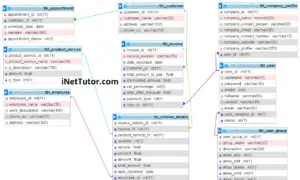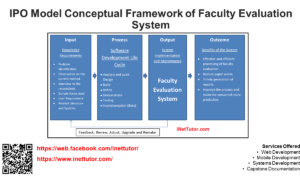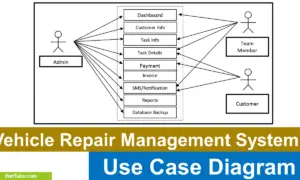QR Code Based Attendance System Conceptual Framework
In today’s fast-paced world, tracking attendance has become a crucial part of every organization. From schools to offices, it’s essential to know who’s present and who’s absent. One of the latest solutions to this problem is a QR Code-based attendance system. It’s easy to use, cost-effective, and efficient. But how does it work? In this article, we’ll explore the conceptual framework behind the QR Code-based attendance system and understand its benefits for organizations. So, whether you’re a school administrator, HR manager, or business owner, keep reading to learn more!
About the Project
Table of Contents
The capstone project, “QR Code Attendance System with SMS Notification” is designed to systematize the attendance system in school. The attendance system will be based on QR codes scanned by students in entering and leaving the school premises. Upon the recording of attendance, the system will generate SMS to notify the parents about the arrival and departure of their children in school. Core features of the QR code student attendance system will focus on time-in/out for attendance, student information encoding, SMS notifications, QR code generation, and scanning reports generation, and database backup.
Objectives of the Study
The general objective of the study on QR Code Based Attendance System is to develop a reliable and efficient system that will accurately track and monitor the attendance of students, faculty members, and staff in educational institutions and other organizations. This system aims to provide a faster and more convenient way of recording attendance compared to traditional manual methods.
Specifically, the study aims the following:
- To develop a QR code-based attendance system with SMS Notification.
- To timely monitor attendance of students during arrival and departure in school.
- To ease up the recording of attendance just by scanning the QR code.
- To transform the traditional attendance system into an advance and technology-assisted system.
- To allow parents to monitor their students by receiving SMS notifications of attendance.
- To develop a system that will let managing attendance records easy and convenient.
- To provide an accurate list and records of Student attendance.
What is a Conceptual Framework?
A conceptual framework is a structured approach used to organize and analyze ideas related to a research project or capstone project. It provides a clear understanding of the research problem, identifies variables, and illustrates the relationship between these variables. In the development of a QR Code Based Attendance System, a conceptual framework serves as a roadmap for the entire project. It outlines the objectives, goals, and expected outcomes of the system, as well as the necessary inputs and processes required to achieve these outcomes.
A QR code-based attendance system’s conceptual framework can be used to pinpoint the critical elements that influence the effectiveness and efficiency of the system. It can also be beneficial to define a precise set of requirements for the system, including the kinds of data to be gathered and the analysis techniques to be employed. A conceptual framework can also offer direction for the development, design, and implementation of the system and help to guarantee that it fulfils the needs of its target audience. Overall, the purpose of a conceptual framework in the development of a QR Code Based Attendance System is to provide a comprehensive and structured approach to developing a successful system that meets its intended goals and objectives.
Conceptual Framework Diagram
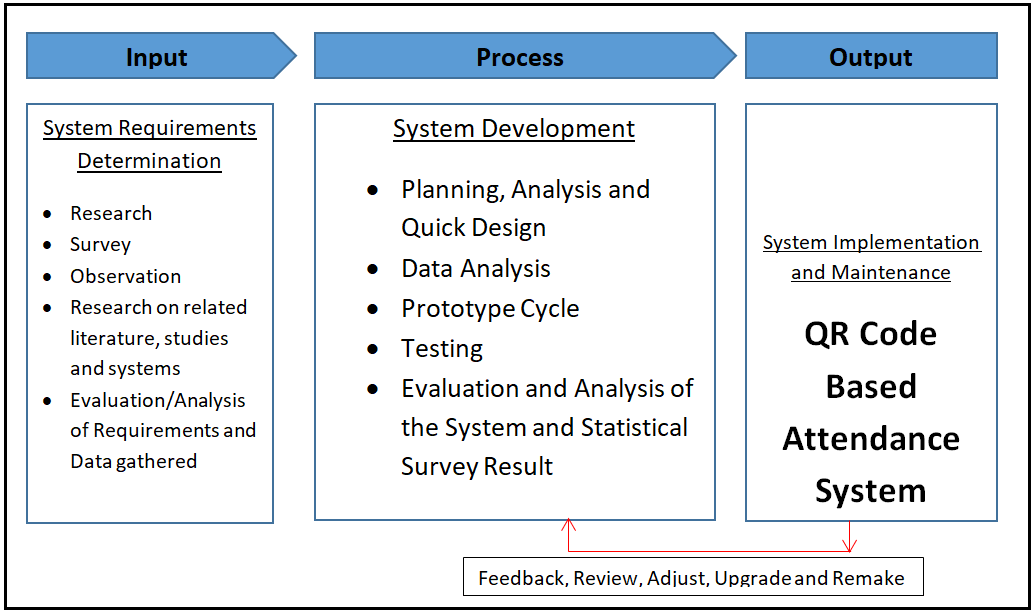
The image shown above is the Conceptual Framework Diagram of the QR Code Based Attendance System. The Conceptual Framework of the capstone project QR Code Based Attendance System is designed using the IPO Model.
Input
In the input phase of the conceptual framework, several activities are performed to gather relevant data and information needed for the project. These activities include research, survey, observation, research on related literature, studies, and systems, and evaluation/analysis of requirements and data gathered.
Research involves investigating and gathering data from various sources, such as academic journals, books, and online articles. This activity aims to provide a better understanding of the project’s scope and to identify any existing solutions to the problem.
Surveys are conducted to gather information from potential users and stakeholders of the QR code-based attendance system. This activity aims to determine the specific requirements and preferences of users, which will help in designing and developing a user-friendly and efficient system.
Observation involves watching and recording how the current attendance system works in the target setting. This activity helps in identifying the strengths and weaknesses of the current system and the possible areas for improvement.
Research on related literature, studies, and systems involves examining existing attendance systems and researching on best practices and new technologies. This activity provides valuable insights and ideas for the development of the QR code-based attendance system.
Evaluation/analysis of requirements and data gathered involves examining the data gathered from the previous activities and analyzing them to identify the project’s specific requirements. This activity aims to ensure that the project aligns with the needs and expectations of the stakeholders and the target users.
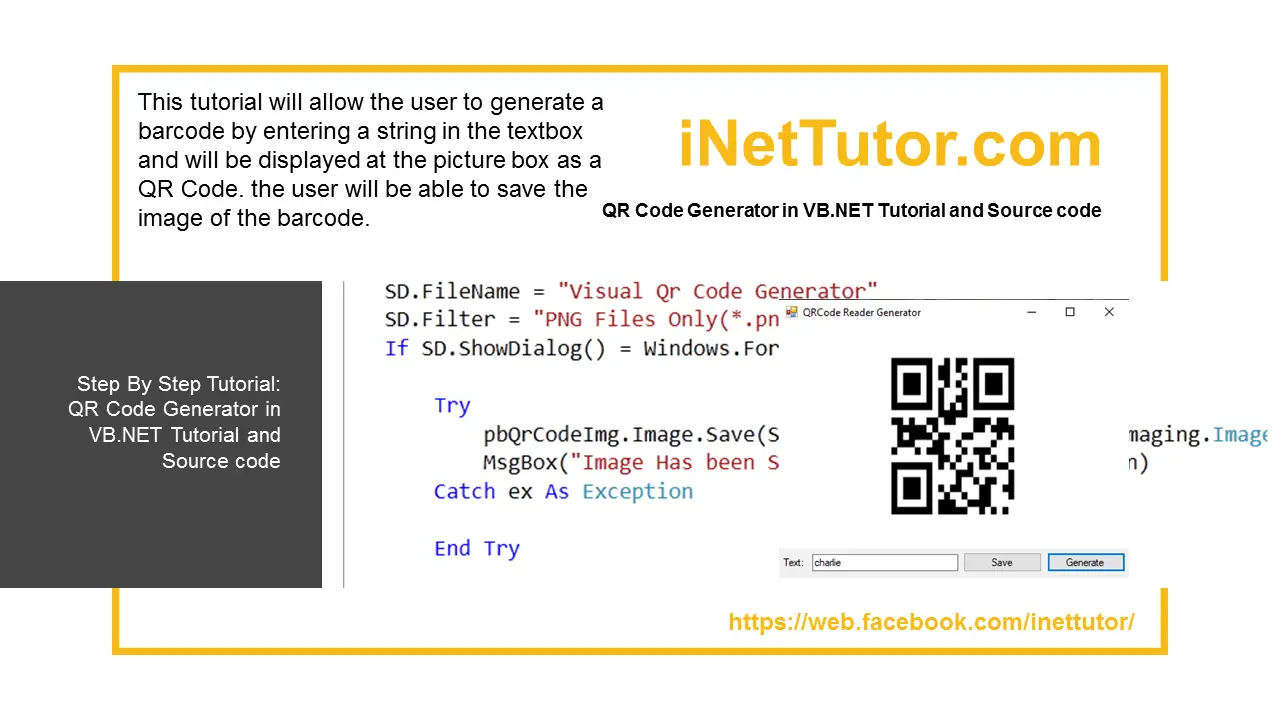
Process
Analysis and Quick Design
During Analysis and Quick Design, the researchers did a personal interview with the respondents and the chosen client where the study was conducted. The respondents were given the chance to suggest how the system will be designed. After conducting the data gathering, the researchers made an initial design for the proposed system.
Data Analysis
The researchers will analyze all the data, user requirements and information. This phase also help the researchers to have an idea on how to create the system and have an idea on how the proposed system would be beneficial to the clients.
System Design
The researchers will start to develop the proposed system. It includes the design; how the system would look like based on user requirements, and the researchers/programmer would like to add personal design to make the system more interactive and user friendly.
Prototype Cycle
This stage will consist of the researchers’ data being compiled, built, demonstrated, and refined. The researchers create a prototype first, based on the planned design and data tables. The prototype will be shown to the client after it has been built. The researchers demonstrate the system’s operation, the flow of how it operates, and the functions of the system’s features. The next stage is refining, in which the researchers will fine-tune the system based on the client’s extra requirements. Changes to the features flow and functionalities will be made based on the needs.
Testing and Evaluation
This will include the feed backing of the proposed system after it will be implemented and had undergone testing by three Experts. It will also inform the researchers and the developer if there are any bugs, suggestion and if the system’s functionality will work well.
This will discuss the implementation of the proposed system wherein Three (3) Experts will evaluate the proposed system. This will also discuss if the recommended functions and suggestion are met.
Output
The project comes to life and is executed in the real world after all of the necessary procedures have been completed. A new project is born, and it will be maintained for the project’s long-term survival.
The output phase of the conceptual framework for a project involves the system implementation, installation to the live environment, and system update or upgrade. This is the stage where the actual system is developed and deployed to the target environment. The implementation phase involves the actual installation of the system, configuring it to work as designed, and setting up the necessary hardware and software components.
Once the system is installed, it is tested to ensure that it meets the requirements and specifications set out in the earlier phases. This involves performing various tests, including integration testing, performance testing, and security testing. Any issues that arise during testing are addressed, and the system is fine-tuned to ensure that it meets the desired performance and security standards.
After the system has been successfully deployed to the target environment, it is important to ensure that it remains up-to-date and functional. This involves ongoing maintenance and periodic upgrades to keep the system current with the latest technologies and security standards. It is also important to have a plan in place for handling any unexpected downtime or issues that may arise, to minimize the impact on users and ensure that the system is back up and running as quickly as possible.
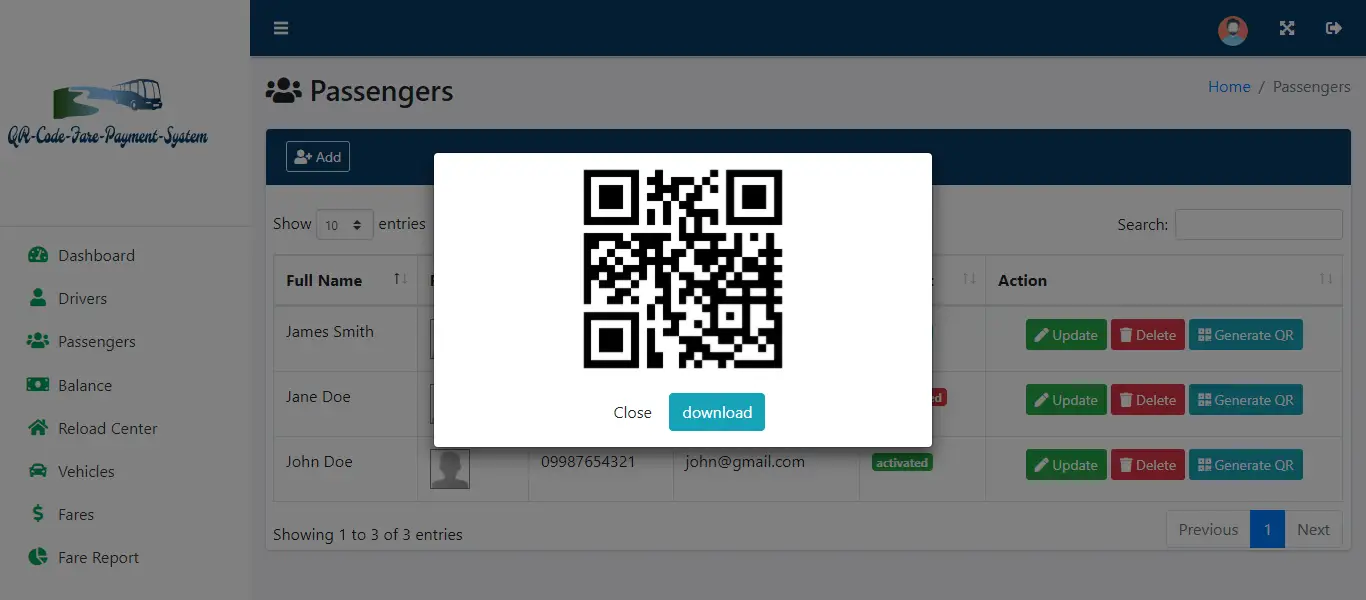
Summary
The QR Code Based Attendance System is a modern solution for the conventional attendance system that is usually done manually. To properly develop such a system, a conceptual framework is needed, and the Input-Process-Output model is an effective tool to achieve this. The input phase of the model includes activities such as research, survey, observation, and research on related literature, studies, and systems, and evaluation/analysis of requirements and data gathered. The process phase involves designing, developing, and testing the system, while the output phase includes system implementation, installation to the live environment, and system update or upgrade. The system implementation and maintenance phase are critical to ensure the system’s proper functioning and continued development to meet the changing needs of its users. By utilizing the IPO model, the development of the QR Code Based Attendance System will be more structured, systematic, and efficient, resulting in a high-quality and user-friendly system.
Readers are also interested in:
QR Code Attendance System Use Case Diagram
IPO Model Conceptual Framework of QR Code Fare Payment System
You may visit our Facebook page for more information, inquiries, and comments. Please subscribe also to our YouTube Channel to receive free capstone projects resources and computer programming tutorials.
Hire our team to do the project.
